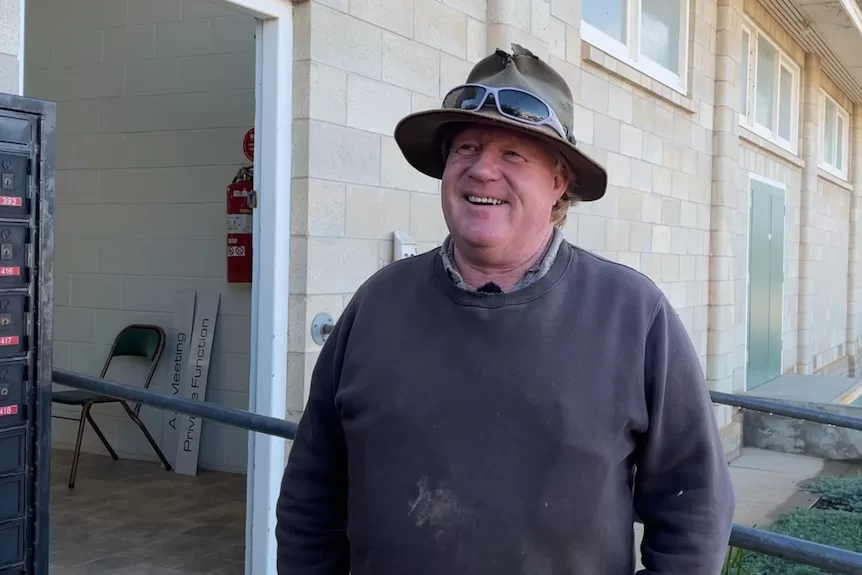If you visited the Kingston on Murray community hall recently, you might be surprised to find the town’s mail being sorted by the owners of the nearby caravan park.
The town is the latest rural community having to take drastic measures to maintain a local base for its postal service.
Located on the banks of the South Australian stretch of the Murray River, the community of Kingston on Murray was told the postal service would be relocated 40 kilometres away if no-one could take it over locally.
That is when Geoff and Barbara Calvert, owners of the Kingston on Murray caravan park, put their hands up to voluntarily keep their community connected.
“We had 14 days to get someone in the town to take over the post office or it was going to go to Loxton,” Mr Calvert said.
“If people can’t get mail, it makes life very difficult … especially in the country.”
Community member Mike Smith also helped save the service at the last minute and said it was a “no-brainer” for the future of the town.
“Once you lose it, you’re not going to get it back,” he said.
Letter volume down but importance up
Australia’s postal system started as the main way for people to stay in touch in pre-Federation times.
More than 200 years later, despite the huge advances in technology and evolution in how people communicate, the postal service is still important to rural and regional communities.
The volume of letters sent annually has rapidly declined, halving in the 11 years between 2008 and 2019.
But according to a 2020 survey by Australia Post, almost one-third of residents in regional and rural Australia believed the post office’s role as a provider of services to local communities had increased in importance over the past five years.
National Archives assistant state manager SA Emily Richardson says, “Even in this day of instant communications, the post is still very important, especially for rural areas”.
“Quite often our postal service is what sends us our clothes and sometimes our food and medicines,” she said.
“But a lot of it is keeping in touch and not feeling you’re out there on your own in really isolated areas.”
More than just mail
Just up the road from Kingston on Murray sits the tiny town of Moorook. Here, former postmistress Joan Hoffmann stepped into the job in 1968.
Over 14 years, she saw the significance of post offices for the small regional community.
“The post office wasn’t just a place for posting, because there were people who needed extra help,” she said.
“I had one customer who was an opal miner from Coober Pedy and couldn’t write except his name, so I would help him with his cheques. He gave me a beautiful green opal when he left.
“[I’ve seen] the changes since then, the convenience of what we have now and the way we can communicate with one another.”
These services are just a few of thousands across Australia.
The postal network is made up of 4,310 post offices, with more than half based in rural and remote areas.
The network also has more than 3,500 licensed post offices and community postal agencies, with more than 2.7 billion items delivered nationally in 2022.
Sending in the early days
Ms Richardson said the early days of mail delivery was a lot more ad hoc.
“It started in 1809 in New South Wales when ex-convict, Isaac Nicholls, became the first postmaster and ran a post office from his Sydney home,” she said.
“Before that, people would send mail through transport organisations and you would rely on your neighbours to bring mail to you.
“People were quite happy when it became more formalised.”
Tasmania was not far behind and established its own post office in Hobart by 1812, with other states setting up their own individualised services through to the 1840s.
“It was a treasured thing because we’d put pen to paper and write to one another, and it could take a really long time to hear from people,” Ms Richardson said.
The launch of the Overland Telegraph and the introduction of telephone exchanges in the 1870s resulted in post offices becoming communication hubs for Australians, no matter where they were based.
“People were going there not just for their mail, but to send telegrams and call people,” Ms Richardson said.
“In 1901, with Federation, the Commonwealth assumed responsibility for the post and around 5,000 post offices.
“As towns and cities grew, postal depots were introduced in the 1950s as a place to sort letters and parcels separately from the post office.”
In 1975, Australia Post was officially established, splitting the telecommunications responsibilities with Telecom, now known as Telstra.
Ms Richardson said as the years went by, post offices moved more into the retail space, a trend she expected would continue into the future.
Loading
